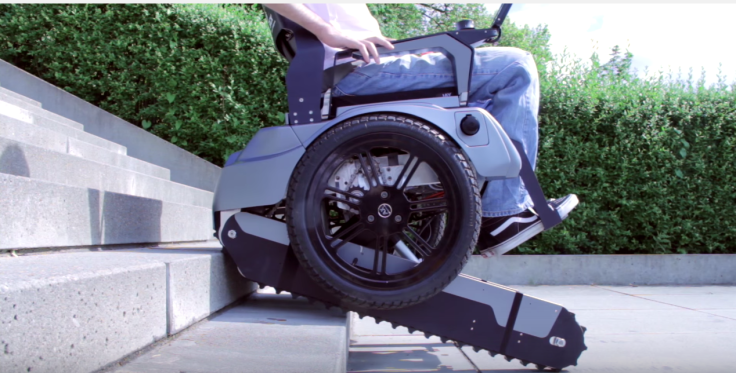Scalevo, An Electric Wheelchair, Can Climb Most Staircases And Hopes To Negate The Need For Ramps And In-Home Lifts

Though the first wheelchair patent was handed out in the U.S. in 1869, the overall design of it hasn’t changed much in the years since. It’s basically a seat with wheels attached. Sometimes it’ll have footrests, or handles on the back for someone to help propel the person forward. One of the most glaring flaws of a wheelchair, however, is the fact that it cannot get up stairs. Remodeling a home or office to be wheelchair accessible can be time consuming and costly, too, since there’s more to it than just putting a ramp in front of your door. A team of Swiss students has now invented a new type of wheelchair capable of getting around the need for wheelchair ramps.
Enter the Scalevo Wheelchair, created by a team of 10 students at the Swiss Federal Institute of Technology (ETH Zurich) and the Zurich University of the Arts. The electric-powered Scalevo operates sort of like a Segway; when on flat ground, it uses two big wheels for balance, allowing the user to control movement by leaning forward or backward. It can also swivel on the spot to change direction, and features rubber tracks that resemble the treads of a tank. All of this can be summoned at the press of a button to allow the user to climb a staircase — even a spiral one.
According to Miro Voellmy, one of the chair’s creators, the rubber tracks make the system completely safe, even on cracked or uneven staircases. “Tracks are excellent for this use because they have a very large footprint, which makes it near impossible to tilt, and they are also very smooth, so it doesn’t feel like you’re driving up stairs, it just feels like you’re driving up a ramp because they’re so flat and they adapt to the stair profile,” Voellmy said in a press release. “So it doesn’t matter if the stair is wooden or metal or glass, the tracks grip and there’s no danger of slipping.”
When Scalevo reaches a set of stairs, the user turns the wheelchair around because, as you’ll see in the video below, Scalevo ascends stairs backwards. With the press of a button, the user lowers the tracks, which grip onto the first step of the stairs and slowly move the whole chair upward. As it gets further up the stairs, a small set of wheels appear to ensure that it doesn’t tip over. The user is able to see what is below them as they travel, and what is ahead of them on the stairs through a small camera fitted to the arm of Scalevo. This works in the same way that a car’s backup camera works.
Every process the Scalevo goes through is automated, except speed, making it easy to use. “If I want to climb the stairs I can just drive up to them, turn around, press one button and all I have to do is control the velocity I want to drive at,” Voellmy said. “The alignment on the stairs, the leveling of the wheelchair driver, is automated and the user can control it, he can view the back with a back-facing camera, and have a full, safe, driving experience.”
The Swiss team hopes that their design will one day negate the need for wheelchair-accessible ramps and in-house stair lifts, which would make remodeling a home less drastic and costly — the Scalevo is also very compact. They believe that by the time Scalevo reaches the market, its price will be only be slightly more expensive than the traditional wheelchair.



























